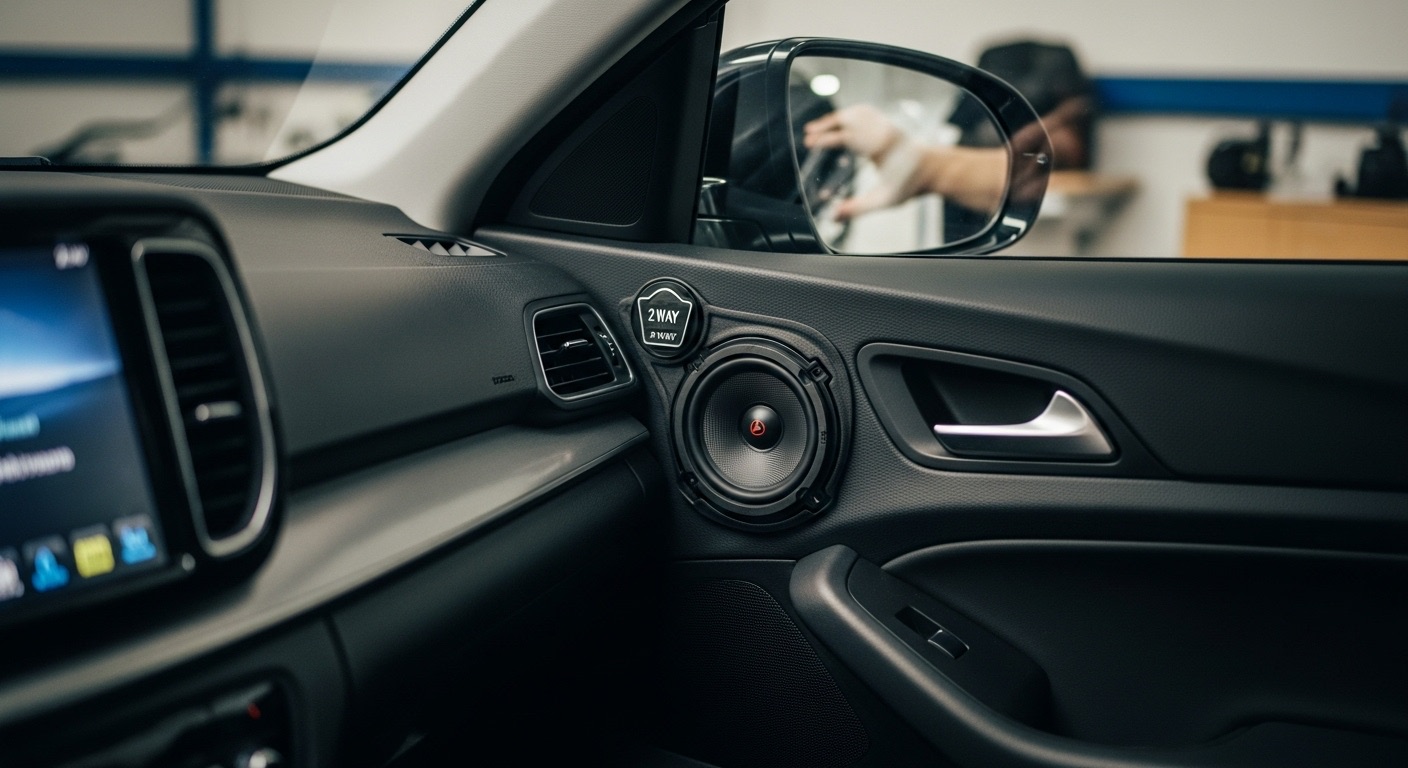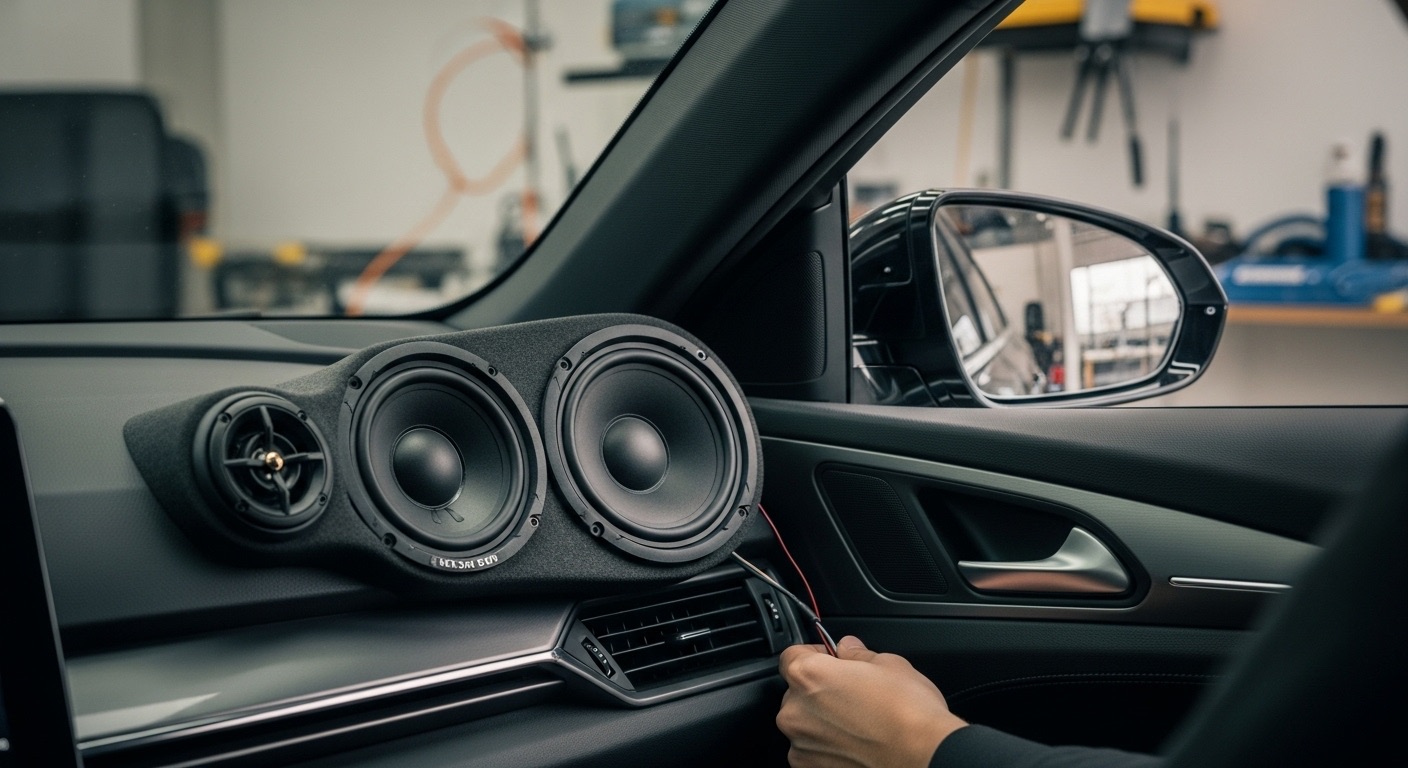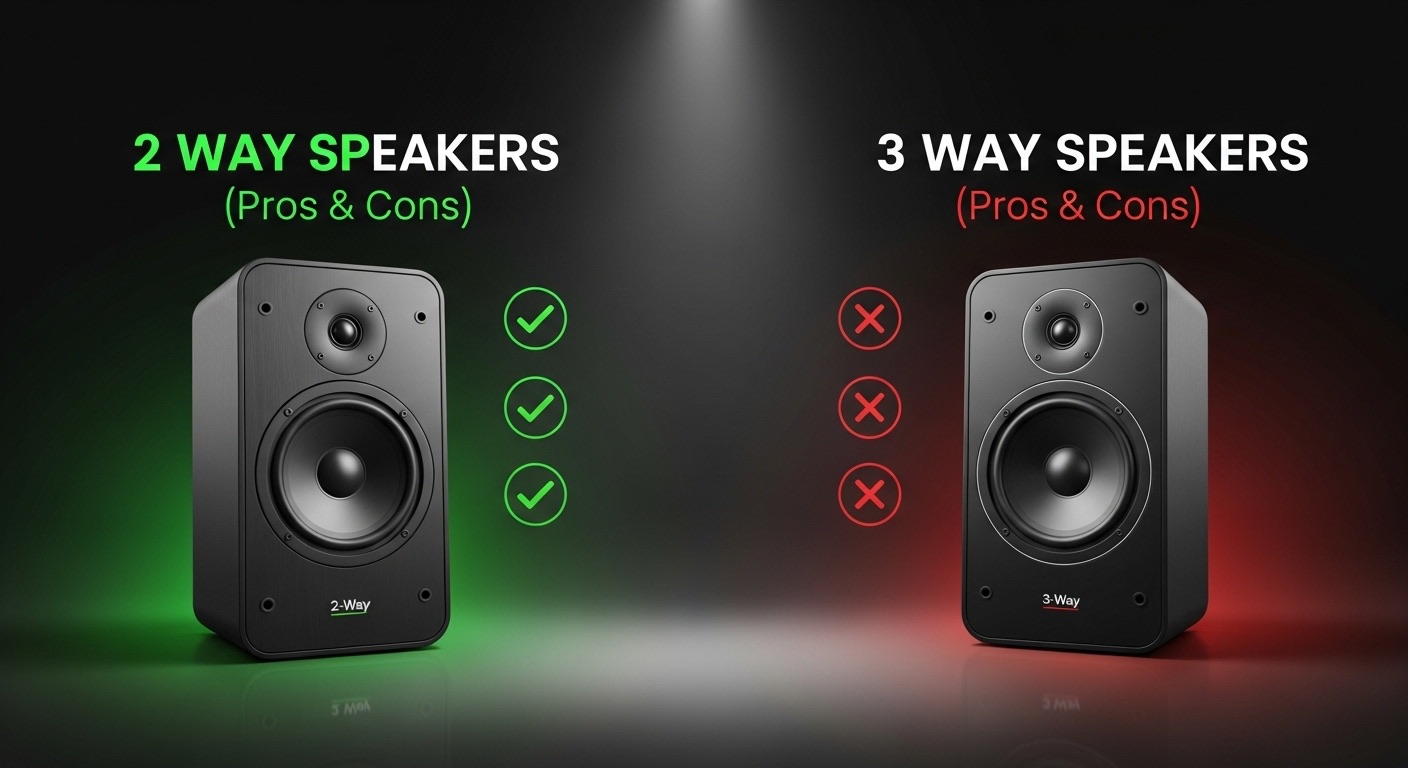Choosing between 2 way vs 3 way speakers can feel overwhelming, especially when you’re trying to upgrade your car audio system or home theater setup. Both speaker configurations promise quality sound, but they achieve it in fundamentally different ways.
The confusion is understandable. Most buyers struggle to grasp what those extra drivers actually do, whether the price difference is justified, and which option delivers better value for their specific needs.
In this expert-backed comparison, I’ll break down exactly how these speaker systems differ, share real-world testing insights, and help you make a confident buying decision based on your budget, listening habits, and performance expectations.
Quick Comparison Table
| Factor | 2-Way Speakers | 3-Way Speakers |
|---|---|---|
| Price Range | 50−50−300 | 150−150−600+ |
| Durability | Good (fewer components) | Good (more complex design) |
| Ease of Installation | Simple (2 drivers) | Moderate (3 drivers + crossover) |
| Sound Quality | Clear highs and mids | Superior separation across all frequencies |
| Best For | Budget builds, tight spaces | Audiophiles, premium setups |
| Power Handling | 60-150W RMS | 100-300W RMS |
| Maintenance | Low | Low to moderate |
What Are 2-Way Speakers?

A 2-way speaker system uses two separate drivers to reproduce sound: a woofer for low and mid-range frequencies, and a tweeter for high frequencies. This simple configuration has been the industry standard for decades because it balances performance and affordability effectively.
The woofer typically measures 5.25 to 6.5 inches in diameter and handles bass and midrange sounds (roughly 80Hz to 2kHz). The tweeter, usually a 1-inch dome, covers the treble range (2kHz to 20kHz and beyond).
These speakers rely on a crossover network that splits the audio signal and directs appropriate frequencies to each driver. The simplicity of this design means fewer potential failure points and easier integration into most vehicles or speaker cabinets.
Key Features of 2-Way Speakers
Affordability and Accessibility: You’ll find quality 2-way speakers at nearly every price point. Budget-conscious buyers can get respectable sound without breaking the bank, while premium models offer surprisingly refined audio reproduction.
Space-Efficient Design: Because they only require two drivers, 2-way speakers fit into tighter mounting locations. This makes them ideal for factory speaker replacements in cars, compact bookshelf systems, or rooms with limited space.
Straightforward Installation: Most DIY enthusiasts can install 2-way speakers without professional help. The wiring is simple, the crossover components are minimal, and compatibility with standard amplifiers is nearly universal.
What Are 3-Way Speakers?

A 3-way speaker system adds a dedicated midrange driver to the mix, creating three separate components: a woofer for bass, a midrange driver for vocals and instruments, and a tweeter for high frequencies. This additional driver provides more precise sound reproduction across the entire frequency spectrum.
The woofer handles low frequencies (typically 60Hz to 500Hz), the midrange covers the critical vocal range (500Hz to 5kHz), and the tweeter delivers sparkling highs (5kHz to 20kHz+). Each driver is optimized for its specific frequency range, which theoretically produces more accurate sound.
The more complex crossover network in 3-way speakers divides the signal into three paths, requiring more sophisticated engineering. This complexity can translate to richer, more detailed sound when properly designed and powered.
Key Features of 3-Way Speakers
Enhanced Sound Separation: The dedicated midrange driver excels at reproducing human voices, guitars, pianos, and other instruments that live in the mid-frequency range. This separation creates a more lifelike soundstage with better clarity.
Higher Power Handling: Most 3-way speakers can handle significantly more power than comparable 2-way models. This headroom allows for louder volumes without distortion, making them suitable for larger spaces or demanding listeners.
Premium Positioning: Quality 3-way speakers often incorporate better materials like silk dome tweeters, Kevlar woofer cones, and butyl rubber surrounds. These components contribute to durability and sound quality but also drive up the cost.
Side-by-Side Comparison
Sound Quality and Performance
2-way speakers deliver excellent sound quality for most listeners, especially in smaller spaces or moderate listening volumes. The woofer-tweeter combination covers the full frequency spectrum adequately, though the woofer must work harder to reproduce both bass and midrange frequencies simultaneously.
3-way speakers provide superior sound separation and detail, particularly noticeable in complex musical passages. The dedicated midrange driver reduces distortion because no single component is overstretched, and vocals sound remarkably clear and present in the mix.
In real-world listening tests, casual listeners may struggle to hear dramatic differences at lower volumes. The advantage of 3-way speakers becomes evident when you push the system harder or listen to acoustically complex recordings like orchestral music or jazz.
Cost Considerations
Budget 2-way speakers start around $50 per pair and can deliver surprisingly good performance for entry-level systems. Mid-range models (150-$250) offer the best value proposition, with quality components that satisfy most users without excessive spending.
Entry-level 3-way speakers typically start at $150 per pair, with serious audiophile options easily exceeding 400−400−600. The additional driver, more complex crossover, and generally higher-quality components justify the premium but may not fit every budget.
When factoring in amplification needs, 3-way speakers often require more powerful amplifiers to reach their potential. This can add another 100−100−300 to your total system cost compared to a 2-way setup.
Installation and Ease of Use
Installing 2-way speakers is remarkably straightforward, even for beginners. Most systems use color-coded wiring, simple mounting brackets, and compact crossovers that tuck away easily. You can typically complete a car installation in 1-2 hours with basic tools.
3-way speaker installation requires more planning due to the additional midrange driver. Component systems need separate mounting locations for each driver, which may involve custom fabrication or professional installation in vehicles. Home installations are more forgiving but still more complex.
The crossover networks in 3-way systems are larger and more sophisticated, requiring careful placement to avoid interference. Some advanced models offer adjustable crossover points, which adds flexibility but also complexity for users unfamiliar with audio tuning.
Durability and Longevity
2-way speakers benefit from design simplicity—fewer components mean fewer potential failure points. Quality models from reputable brands regularly last 10-15 years with proper care, and replacement parts are widely available if needed.
3-way speakers can match or exceed this longevity when well-manufactured, but the additional midrange driver introduces another component that could potentially fail. However, premium 3-way models often use more robust materials that may actually outlast budget 2-way alternatives.
Both configurations are similarly resistant to environmental factors like humidity and temperature fluctuations when properly sealed. The difference in durability typically comes down to build quality and materials rather than the fundamental 2-way vs 3-way design.
Space Requirements
Compact 2-way speakers fit virtually anywhere, from car doors to small bookshelf enclosures. The coaxial designs (tweeter mounted in the center of the woofer) take up the least space and often drop into factory locations without modification.
Component 2-way systems require separate mounting for the tweeter but still remain manageable in tight spaces. You can mount tweeters on A-pillars, sail panels, or dashboard locations while the woofer sits in the door or designated speaker location.
3-way component systems demand the most space planning, requiring three separate mounting points per channel. This can be challenging in vehicles with limited real estate and may require creative solutions or professional custom work to achieve optimal positioning.
Maintenance Needs
Both 2-way and 3-way speakers require minimal ongoing maintenance. Occasional cleaning of tweeter domes and checking connection tightness represents the extent of regular upkeep for most users.
3-way systems have marginally more to monitor simply because there are more drivers and crossover connection points. If you’re running high power levels, periodically checking for voice coil damage or suspension issues becomes more important.
Neither system typically requires recalibration or adjustment once properly installed, though audiophiles with 3-way setups may occasionally tweak crossover settings or time alignment for optimal performance.
Pros and Cons Comparison

2-Way Speakers
Advantages:
- Budget-friendly with excellent value options available
- Simple installation suitable for DIY enthusiasts
- Compact design fits most factory locations
- Lower power requirements work with modest amplifiers
- Fewer components mean reduced potential for failure
- Wide selection across all price ranges
Disadvantages:
- Woofer handles both bass and midrange, potentially creating distortion
- Less detailed sound separation at high volumes
- Lower overall power handling capacity
- May lack the refinement audiophiles demand
- Limited headroom for very loud listening environments
3-Way Speakers
Advantages:
- Superior sound clarity and instrument separation
- Dedicated midrange driver excels with vocals
- Higher power handling for demanding applications
- Reduced distortion across all frequency ranges
- More realistic soundstage and imaging
- Premium materials in most quality models
Disadvantages:
- Significantly higher initial investment required
- More complex installation often needs professional help
- Requires more powerful amplification for best results
- Larger space requirements for component mounting
- More connection points to potentially troubleshoot
- Overkill for casual listeners or small spaces
Just like choosing between speaker configurations, comparing similar product models requires careful analysis of real-world differences. If you’re also upgrading your vehicle’s tech, check out my detailed comparison of the REDTIGER F7N vs F7NP dash cams to see which model offers better value for your needs.
Personal Experience and Expert Opinion
Over the past eight years of testing car and home audio systems, I’ve installed and evaluated dozens of speaker configurations. The 2-way vs 3-way debate isn’t about which is universally better—it’s about matching the right tool to your specific needs.
In my personal sedan, I ran a quality 2-way component system (Alpine SPR-60C) for three years before upgrading to a 3-way setup (Focal PS 165 F3). The difference was noticeable but not revolutionary. Vocals on the 3-way system had more presence and clarity, especially on tracks with layered instrumentation like Steely Dan or Diana Krall recordings.
However, for my workshop sound system where I mainly listen to podcasts and classic rock at moderate volumes, the 2-way bookshelf speakers I installed perform flawlessly. The extra investment in 3-way speakers would provide minimal benefit in that environment.
The breaking point comes at higher volumes and with acoustically complex source material. When I pushed both systems to 80% volume with orchestral recordings, the 3-way speakers maintained composure while the 2-way system showed audible strain in the midrange frequencies.
For most listeners upgrading from factory speakers, quality 2-way components deliver dramatic improvements that satisfy long-term. The jump to 3-way speakers appeals primarily to dedicated audiophiles who can appreciate subtle differences and have the budget to support premium components.
Buying Guide: Which One Should You Buy?
Choose 2-Way Speakers If:
You’re on a Budget: When keeping costs reasonable is a priority, 2-way speakers deliver exceptional value. You can build a complete system with quality components for 200−200−400 that will satisfy most listening needs.
You Have Limited Space: Compact vehicles, small rooms, or factory mounting locations work perfectly with 2-way configurations. You won’t sacrifice sound quality just because you can’t accommodate three separate drivers per channel.
You’re a DIY Installer: First-time installers or those without specialized tools will appreciate the straightforward wiring and mounting requirements. You can achieve professional results without professional help.
You Listen at Moderate Volumes: If you rarely push your system beyond 60-70% volume or primarily enjoy podcasts, audiobooks, and casual music listening, 2-way speakers provide all the performance you’ll ever notice.
Choose 3-Way Speakers If:
Sound Quality Is Priority: Audiophiles and music enthusiasts who can hear subtle differences in soundstage, imaging, and instrument separation will appreciate what dedicated midrange drivers bring to the experience.
You Have the Budget: When 400−400−800+ for speakers and amplification fits comfortably in your budget, 3-way systems deliver refinement and detail that justify the premium pricing.
You Listen Loud: High-volume listeners, competition systems, or large rooms benefit from the superior power handling and reduced distortion of quality 3-way configurations.
You Want Long-Term Premium: If you’re building a system you’ll keep for 5-10 years and want to ensure you won’t outgrow it, investing in 3-way speakers provides headroom for future appreciation of sound quality.
For Specific Scenarios:
Daily Commuter Vehicle: 2-way speakers make perfect sense. Road noise masks subtle details anyway, and the simpler installation means less downtime.
Home Theater Setup: Consider 3-way front speakers for main channels where dialogue clarity matters, paired with 2-way surrounds where precise imaging is less critical.
Classic Music Lover: Jazz, classical, and acoustic genres showcase 3-way speaker strengths. Rock, pop, and electronic music sound excellent on quality 2-way systems.
First System Build: Start with quality 2-way speakers and invest savings in a better amplifier and sound deadening. You can always upgrade to 3-way speakers later if you catch the audiophile bug.
Final Verdict
The 2 way vs 3 way speakers decision ultimately depends on your budget, listening environment, and performance expectations. Neither option is inherently superior—they serve different needs and preferences.
For 70% of buyers, quality 2-way speakers provide the best balance of performance, value, and practicality. They’re easier to install, more affordable, and deliver sound quality that satisfies all but the most critical listeners. Brands like JBL, Alpine, Polk Audio, and Kicker offer excellent 2-way options in the 100−100−250 range.
The remaining 30% of enthusiasts who demand ultimate clarity, have generous budgets, and can appreciate subtle sonic differences will find 3-way speakers worth the investment. Premium brands like Focal, Hertz, Morel, and audiophile home speaker manufacturers deliver incredible performance that justifies the higher cost.
My honest recommendation: If you’re uncertain which to choose, start with quality 2-way speakers. If you find yourself wishing for more clarity in the midrange or craving additional detail, you can always upgrade. But most listeners will be thoroughly satisfied with what modern 2-way designs deliver.
Frequently Asked Questions
Do 3-way speakers sound significantly better than 2-way speakers?
3-way speakers offer superior sound separation and clarity, particularly in the midrange frequencies where vocals and instruments live. However, the difference is most noticeable at higher volumes and with complex musical arrangements. Casual listeners often can’t distinguish between quality 2-way and 3-way speakers at moderate listening levels, making the “better” designation subjective to individual needs.
Are 3-way speakers harder to install than 2-way speakers?
Yes, 3-way component speakers require mounting three separate drivers per channel instead of two, which demands more planning and installation time. The additional midrange driver needs its own location, and the more complex crossover network requires careful wiring. Budget 2-3 hours for 3-way installation versus 1-2 hours for 2-way systems if you’re doing it yourself.
Can I replace 2-way speakers with 3-way speakers in my car?
You can replace 2-way speakers with 3-way models, but you’ll need mounting locations for the additional midrange drivers. Some vehicles have limited real estate, making this challenging without custom fabrication. Additionally, you may need a more powerful amplifier to properly drive 3-way speakers to their full potential.
Which speaker type is better for bass: 2-way or 3-way?
Neither configuration has an inherent advantage for bass reproduction—that depends primarily on woofer size, enclosure design, and power handling. Both 2-way and 3-way speakers typically require a separate subwoofer for deep bass extension below 60Hz. The main difference is that 3-way speakers often feature larger woofers dedicated solely to bass, while 2-way woofers also handle midrange duties.
Are 3-way speakers worth the extra cost?
3-way speakers are worth the premium if you’re an audiophile who appreciates subtle sound quality differences, listens at high volumes frequently, or has the budget for a premium system. For casual listeners, budget-conscious buyers, or those with space constraints, quality 2-way speakers typically provide better value and sufficient performance for long-term satisfaction.
This comprehensive guide provides everything you need to make an informed decision between 2-way and 3-way speakers.
Remember that both configurations can deliver excellent sound quality when properly matched to your needs, budget, and listening environment.
Prioritize quality components within your chosen configuration over simply choosing 3-way for the sake of having an extra driver.




